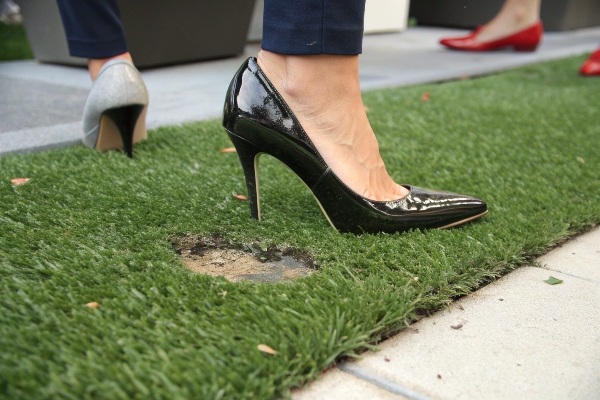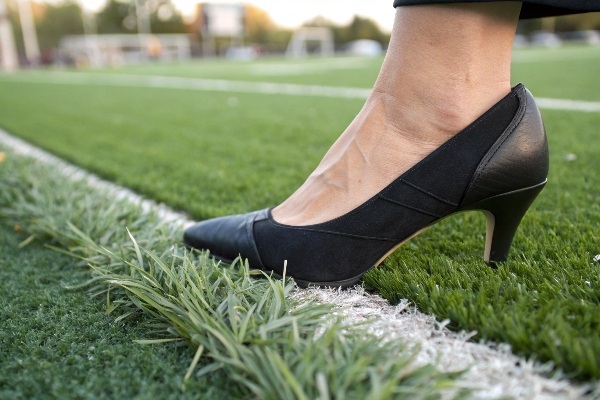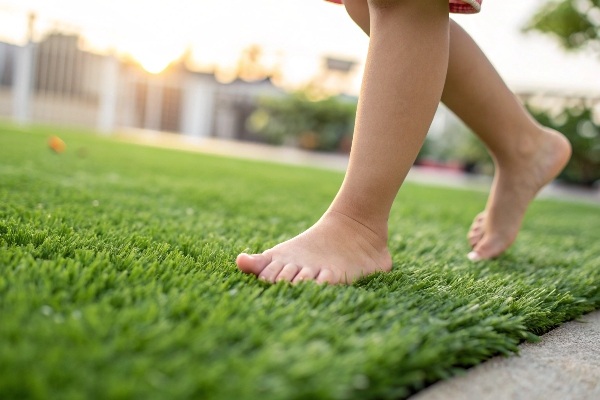Hosting an event on your perfect lawn, you worry about damage. High heels, in particular, can be a major concern. Here’s what you need to know to protect your investment.
Generally, you should not wear high heels, especially stilettos, on artificial turf. The sharp, pointed heels can exert immense pressure, potentially puncturing the turf’s backing, displacing the infill, and damaging the grass fibers. It’s always best to choose footwear with a wider, flatter sole.

Your artificial grass is a big investment. You want it to look great for years. Understanding how different types of footwear affect it is key. It helps you set rules for parties or events and keep your lawn in top condition. Let’s look deeper into what shoes are safe and what to avoid to ensure your turf stays beautiful.
What heels are best for turf?
You’re planning a party and heels are part of the dress code. You don’t want to ban them completely but fear for your lawn. The right type of heel makes all the difference.
Block heels1, wedges, or chunky heels are the best options for artificial turf. Their wider surface area distributes weight more evenly. This reduces the pressure on any single point, preventing damage to the turf backing and keeping the grass blades from being crushed. Stilettos2 should always be avoided.

The main problem with stiletto heels is pressure. Think about it this way: a 120-pound person’s weight on a tiny stiletto tip creates enormous pressure, like a nail being pushed into the ground. This pressure can easily poke a hole through the turf’s protective backing. Once the backing is punctured, it can lead to rips, separated seams, and uneven surfaces that are difficult to repair. I once saw a beautiful event lawn ruined after a wedding because nobody thought about the footwear.
Block heels1 and wedges are a much safer choice. They spread the weight across a larger area, so the pressure is much lower. This prevents the heel from digging into the turf.
Here’s a simple comparison:
| Heel Type | Risk Level | Why? |
|---|---|---|
| Stiletto | High | Concentrates pressure, can puncture backing. |
| Kitten Heel | Moderate | Still a small point, risk of damage remains. |
| Block Heel | Low | Distributes weight over a wider surface. |
| Wedge | Low | Spreads weight evenly across the entire sole. |
The turf’s quality also matters. A high-density turf with a durable backing and a good layer of infill can handle more stress than a lower-quality product.
What Should You Not Put On Artificial Grass?
Artificial grass is tough, but it’s not indestructible. Certain items can cause permanent damage, leading to expensive repairs. Knowing what to avoid is just as important as regular maintenance.
You should never put sharp objects, open flames, or harsh chemicals on artificial grass. This includes things like stiletto heels, grills, fire pits, glass, and chemicals like bleach or strong solvents. These can puncture, melt, or discolor the turf fibers, causing permanent damage.

Let’s break down the main things you need to keep away from your beautiful lawn. I’ve grouped them into three main categories based on the type of damage they can cause. From my experience as an engineer, these are the most common culprits behind turf damage that could have been easily avoided.
Sharp and Heavy Objects
This category includes more than just high heels. Think about furniture with narrow legs, like wrought iron chairs or tables. The weight can press down and crush the grass fibers or even dent the base layer. When I help customers plan their landscaping, I always suggest using furniture coasters or placing heavy items on a small mat to distribute the weight. Also, be careful with tools. A dropped spade or rake can easily puncture the backing.
Heat and Fire
Artificial turf is essentially made of plastic, so it will melt when exposed to high heat. Never place a barbecue grill, fire pit, or any heat source directly on the turf. Hot embers can fly out and melt small spots instantly. Another hidden danger is sunlight reflection. Intense sunlight bounced off a window or shiny metal can act like a magnifying glass, creating a hot spot that melts the grass. It’s something many people don’t consider until it’s too late.
Harsh Chemicals
Your lawn is resistant to many things, but not harsh chemicals. Spilling gasoline, paint thinner, or bleach will cause discoloration and can weaken the plastic fibers, making them brittle. Also, avoid using any cleaners that contain acid or alcohol. For most spills and cleaning, mild soap and water are all you need.
Can you walk barefoot on artificial grass?
You love the feeling of soft grass under your feet. But with an artificial lawn, you might wonder if it’s comfortable or safe. The answer might surprise you and your feet.
Yes, you can definitely walk barefoot on modern artificial grass. High-quality turf is designed to be soft and non-abrasive, feeling great on bare feet. The only thing to be mindful of is that it can get hot in direct, intense sunlight, so test the temperature first.

The experience of walking barefoot on artificial turf has changed so much over the years. The old-style "astroturf" was often stiff and scratchy. But today’s products are very different. We use high-quality polyethylene (PE) fibers, which are much softer and more flexible than the older polypropylene (PP) materials. The result is a surface that feels surprisingly similar to a well-maintained natural lawn, making it perfect for kids to play on or for you to just relax.
The main concern people have is heat. It’s true that artificial grass absorbs more heat from the sun than natural grass. On a very hot summer day, it can become too warm to walk on comfortably. This happens because natural grass has water inside it, which has a cooling effect, but artificial fibers don’t. However, we have solutions for this. I often recommend a light-colored sand or a specialized cooling infill, like TPE, which doesn’t heat up as much as traditional black rubber crumb infill. A quick spray with a garden hose can also cool the surface down in seconds, making it ready for barefoot enjoyment.
Conclusion
To keep your lawn looking great, avoid sharp heels and heat sources. But don’t be afraid to enjoy it—walking barefoot is perfectly fine, just check the temperature on sunny days.
_画板-1.png)
_画板-1.png)